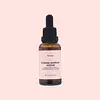What's inside
What's inside
 Key Ingredients
Key Ingredients

 Benefits
Benefits

 Concerns
Concerns

No concerns
 Ingredients Side-by-side
Ingredients Side-by-side

Water
Skin ConditioningGlycerin
HumectantNiacinamide 5%
SmoothingPropylene Glycol
HumectantCeramide NP
Skin ConditioningCeramide Ns
Skin ConditioningCeramide As
Skin ConditioningCeramide AP
Skin ConditioningCeramide EOP
Skin ConditioningAlpha-Glucan Oligosaccharide
CleansingHydrolyzed Centella Asiatica Extract
AntioxidantPolygonum Cuspidatum Root Extract
AntioxidantScutellaria Baicalensis Root Extract
AstringentCamellia Sinensis Leaf Extract
AntimicrobialGlycyrrhiza Glabra Root Extract
BleachingChamomilla Recutita Flower Extract
MaskingRosmarinus Officinalis Leaf Extract
AntimicrobialHyaluronic Acid
HumectantPanthenol
Skin ConditioningSodium PCA
HumectantUrea
BufferingTrehalose
HumectantPolyquaternium-51
Skin ConditioningTriacetin
AntimicrobialSqualane
EmollientCholesterol
EmollientDipotassium Glycyrrhizate
HumectantHydrogenated Lecithin
EmulsifyingButylene Glycol
Humectant1,2-Butanediol
HumectantCaprylyl Glycol
EmollientGlyceryl Stearate
EmollientPolyacrylate Crosspolymer-6
Emulsion StabilisingDipropylene Glycol
HumectantWater, Glycerin, Niacinamide 5%, Propylene Glycol, Ceramide NP, Ceramide Ns, Ceramide As, Ceramide AP, Ceramide EOP, Alpha-Glucan Oligosaccharide, Hydrolyzed Centella Asiatica Extract, Polygonum Cuspidatum Root Extract, Scutellaria Baicalensis Root Extract, Camellia Sinensis Leaf Extract, Glycyrrhiza Glabra Root Extract, Chamomilla Recutita Flower Extract, Rosmarinus Officinalis Leaf Extract, Hyaluronic Acid, Panthenol, Sodium PCA, Urea, Trehalose, Polyquaternium-51, Triacetin, Squalane, Cholesterol, Dipotassium Glycyrrhizate, Hydrogenated Lecithin, Butylene Glycol, 1,2-Butanediol, Caprylyl Glycol, Glyceryl Stearate, Polyacrylate Crosspolymer-6, Dipropylene Glycol
Water
Skin ConditioningHyaluronic Acid
HumectantSodium Hyaluronate
HumectantButylene Glycol
HumectantPanthenol
Skin ConditioningPhenoxyethanol
PreservativeGlycerin
HumectantTrehalose
HumectantOphiopogon Japonicus Root Extract
Skin ConditioningOpuntia Ficus-Indica Stem Extract
Skin ConditioningSophora Flavescens Root Extract
Antioxidant1,2-Hexanediol
Skin ConditioningAcrylates/C10-30 Alkyl Acrylate Crosspolymer
Emulsion StabilisingHydroxyethylcellulose
Emulsion StabilisingSodium Lactate
BufferingCellulose
AbsorbentEthylhexylglycerin
Skin ConditioningTriethanolamine
BufferingWater, Hyaluronic Acid, Sodium Hyaluronate, Butylene Glycol, Panthenol, Phenoxyethanol, Glycerin, Trehalose, Ophiopogon Japonicus Root Extract, Opuntia Ficus-Indica Stem Extract, Sophora Flavescens Root Extract, 1,2-Hexanediol, Acrylates/C10-30 Alkyl Acrylate Crosspolymer, Hydroxyethylcellulose, Sodium Lactate, Cellulose, Ethylhexylglycerin, Triethanolamine
 Reviews
Reviews

Ingredients Explained
These ingredients are found in both products.
Ingredients higher up in an ingredient list are typically present in a larger amount.
Butylene Glycol (or BG) is used within cosmetic products for a few different reasons:
Overall, Butylene Glycol is a safe and well-rounded ingredient that works well with other ingredients.
Though this ingredient works well with most skin types, some people with sensitive skin may experience a reaction such as allergic rashes, closed comedones, or itchiness.
Learn more about Butylene GlycolGlycerin is already naturally found in your skin. It helps moisturize and protect your skin.
A study from 2016 found glycerin to be more effective as a humectant than AHAs and hyaluronic acid.
As a humectant, it helps the skin stay hydrated by pulling moisture to your skin. The low molecular weight of glycerin allows it to pull moisture into the deeper layers of your skin.
Hydrated skin improves your skin barrier; Your skin barrier helps protect against irritants and bacteria.
Glycerin has also been found to have antimicrobial and antiviral properties. Due to these properties, glycerin is often used in wound and burn treatments.
In cosmetics, glycerin is usually derived from plants such as soybean or palm. However, it can also be sourced from animals, such as tallow or animal fat.
This ingredient is organic, colorless, odorless, and non-toxic.
Glycerin is the name for this ingredient in American English. British English uses Glycerol/Glycerine.
Learn more about GlycerinHyaluronic acid is naturally found in healthy skin. It is a humectant, meaning it draws moisture to your skin.
This ingredient helps hydrate, soothe, and protect the skin.
What makes hyaluronic acid so hydrating? It has the capacity to bind or hold large amounts of water.
Fun fact: It is already naturally found in our bodies, such as the fluids of our eyes and our joints.
Studies find this ingredient to have anti-inflammatory and anti-microbial properties. This can help speed up wound-healing.
Hyaluronic acid can be irritating if the molecule has a low-molecular weight, or if the molecules are small.
One study found low-molecular weight hyaluronic acid to be pro-inflammatory, meaning some people may experience irritation. This is because our bodies use hyaluronic acid in the wound-healing process to signal to our bodies, via irritation, that something needs healing.
The same study found high-molecular weight hyaluronic acid to be anti-inflammatory.
These are some other common types of Hyaluronic Acid:
Learn more about Hyaluronic AcidPanthenol is a common ingredient that helps hydrate and soothe the skin. It is found naturally in our skin and hair.
There are two forms of panthenol: D and L.
D-panthenol is also known as dexpanthenol. Most cosmetics use dexpanthenol or a mixture of D and L-panthenol.
Panthenol is famous due to its ability to go deeper into the skin's layers. Using this ingredient has numerous pros (and no cons):
Like hyaluronic acid, panthenol is a humectant. Humectants are able to bind and hold large amounts of water to keep skin hydrated.
This ingredient works well for wound healing. It works by increasing tissue in the wound and helps close open wounds.
Once oxidized, panthenol converts to pantothenic acid. Panthothenic acid is found in all living cells.
This ingredient is also referred to as pro-vitamin B5.
Learn more about PanthenolTrehalose is a disaccharide made of two glucose molecules (glucose is sugar!). Trehalose is used to help moisturize skin. It also has antioxidant properties.
As a humectant, trehalose helps draw moisture from the air to your skin. This helps keep your skin hydrated.
Due to its antioxidant properties, trehalose may help with signs of aging. Antioxidants help fight free-radical molecules, unstable molecules that may damage your skin.
In medicine, trehalose and hyaluronic acid are used to help treat dry eyes.
Some animals, plants, and bacteria create trehalose as a source of energy to survive freeze or lack of water.
Learn more about TrehaloseWater. It's the most common cosmetic ingredient of all. You'll usually see it at the top of ingredient lists, meaning that it makes up the largest part of the product.
So why is it so popular? Water most often acts as a solvent - this means that it helps dissolve other ingredients into the formulation.
You'll also recognize water as that liquid we all need to stay alive. If you see this, drink a glass of water. Stay hydrated!
Learn more about Water